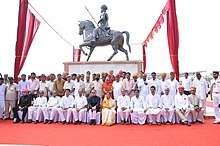Shekha of Amarsar
Maharao Shekha (1433–1488) was a chieftain in 15th-century India. He is the namesake of the Shekhawati region, comprising the districts of Sikar, Churu and Jhunjhunu in the modern Indian state of Rajasthan. His descendants are known as the "Shekhawat" [1].

Birth
On Mokal's Death in AD 1445, the twelve year old Shekha Succeeded his father's estates at Amarsar. His parents are said to have sought prayers of intercession from the Muslim pir Sheikh Burhan, after whom Shekha was named [2]. In due time, Sheikh Burhan fathered an heir, who according to the injunctions of Burhan, was styled after his own tribe, Shekh. He directed that the child should wear a buddea (strings or threads) which, when laid aside, was to be suspended at the saint's durgah; and further, that he should assume the blue tunic and cap, abstain from hog's flesh and eat no meat "in which the blood remained". He also ordained that at the birth of every Shekhawat male infant a goat should be sacrificed, while for female infants nothing special would need to happen. These obligations were religiously maintained for over two hundred years.[3][4]
Coronation
Shekha succeeded as the head of the Nayan and Barwada estate, along with 24 more villages, at the age of 12, as a result of the untimely death of his father Mokal Ji in 1445.[5]
Life
When Shekha inherited his father's estate, his reputation and power attracted the jealousy of the Lord Paramount of Amber. He was attacked, but thanks to the aid of the Punnee Pathans he successfully withstood the reiterated assaults of his suzerain lord. Up to this period they had acknowledged the Amber princes as liege lords, and in token of the alliance paid as tribute all the colts reared on the original estate. A dispute on this point was the ostensible cause (though subordinate to their rapid prosperity) of intermittent separations of the Shekhawat colonies from the parent state, which lasted until the reign of Sawai Jai Singh, who brought submission and pecuniary relief from them. Shekha left a well-established position to his youngest son Raimal.[6][7]. After Raimal , Rao Lunkaran was made the Head of Amarsar. After is Death, the Ancestral seat of Amarsar was succeeded by his Son Rao Manohar. Later Shahpura, became the capital of Old Amarsar - Manoharpur line of Shekhawats.[8]
Death
Shekha died in 1488 fighting the Gaur Rajputs in the war of Ghatwa defending the modesty and self-respect of a newlywed lady. Shekha took his last breath at Ralawta. A cenotaph (Chhatri) was built where he died. A statue of Shekha was also inaugurated in the same place by the President of India Smt. Pratibha Patil.[9]

See also
References
- Hooja, Rima (2006). A History of Rajasthan. Rupa & Company. p. 397.
- Hooja, Rima (2006). A History of Rajasthan. Rupa & Company. p. 397.
- James tod (1873). Clear writing edition of -Annals & Antiquities of Rajasthan or the central & western Rajput states of India. madras Higginbotham and co 165 mount road. p. 359.CS1 maint: date and year (link)
- Hooja, Rima (2006). A History of Rajasthan. Rupa & Company. ISBN 9788129115010.
- Singh Shekhawat, Thakur Surjan. Rao Shekha.
- James tod (1873). Clear writing edition of - Annals & Antiquities of Rajasthan or the central & western Rajput states of India. madras Higginbotham and co 165 mount road. p. 360].CS1 maint: date and year (link)
- Hooja, Rima (2006). A History of Rajasthan. Rupa & Company. ISBN 9788129115010.
- Hooja, Rima (2006). A History of Rajasthan. Rupa & Company. p. 499.
- Sinh, Ranbir (2001). History Of Shekhawats. Jaipur: Publication Scheme. ISBN 8186782745.